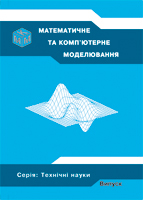Аналіз математичних моделей процесів зневоднення та гранулювання у псевдозрідженому шарі
DOI:
https://doi.org/10.32626/2308-5916.2017-15.86-91Анотація
Розглядаються основні підходи до математичного моделювання процесів переносу у псевдозрідженому шарі, класифікація моделей за типами міжфазної взаємодії, з урахуванням стохастичної і хаотичної гідродинаміки та класифікація процесів в апараті з псевдозрідженим шаром за їх властивостями для гідродинамічних моделейПосилання
Корнієнко Б. Я. Особливості моделювання процесів переносу у дисперсних системах. Вісник Національного технічного університету України «Київський політехнічний інститут», Серія «Хімічна інженерія, екологія та ресурсозбереження». 2011. № 2(8). С. 5–9.
May W. G. Fluidized-Bed Reactor Studies. Chemical engineering progress. 1959. Vol. 55, N. 12. Р. 49–56.
deVries R. J., van Swaaij W. P. M., Mantovani C., Heijkoop A. Design criteria and performance of the commercial reactor for the Shell chlorine process. Pro-ceedigs of 5th European Symposium on Chemical Reaction Engineering. Amsterdam, Elsevier Publ. Corp., 1972. Р. B9-59– B9-69.
van Swaaij W. P. M., Zuiderweg F. J. Investigation of Ozone decomposition in fluidized beds on the basis of a two-phase model. 2nd International Symposium in Chemical Reaction Engineering. Amsterdam, 1972. P. 9–25.
van Deemter J. J., Drinkenburg A. A. H. (Ed.) In fluidization. Netherlands Uni-versity Press, Amsterdam, Netherlands. 1967. P. 334–347.
Orcutt J. C., Davidson J. F., Pigford R. L. Reaction time distribution in fluidized catalytic reactors. Chemical engineering progress symposium series. 1962. Vol. 58, N 38. P. 1–15.
Дэвидсон Дж., Харрисон Д. Псевдоожижение. М.: Химия, 1973. 725 с.
Darton R. C. A bubble growth theory of fluidized bed reactors. Transactions of the Institution of Chemical Engineers. 1979. Vol. 57. P. 134–138.
Partridge B. A., Rowe P. N. Chemical reaction in a bubbling gas-fluidised bed. Transactions of the Institution of Chemical Engineers. 1966. Vol. 44. P. 335–348.
Grace J. R. Fluidized beds as chemical reactors, in gas fluidization technology. John Wiley & Sons, Chichester, New York, Brisbane, Toronto, Singapore, 1986. 428 р.
Куний Д., Левеншпиль О. Промышленное псевдоожижение: пер. с англ. М.: Химия, 1976. 448 с.
Fryer C. C., Potter O. E. Experimental investigation of models for fluidized bed catalytic reactors. AIChE Journal. 1976. Vol. 22. P. 38–47.
Werther J. Mathematical modeling of fluidized bed reactors. International chemical engineering. 1980. Vol. 20. P. 529–541.
Werther J. Mathematische Modellierung von Wirbel schichtreaktoren. Chemie Ingenieur Technik. 1978.Vol. 50, N 11. P. 850–860.
Kato K., Wen C. Y. Bubble assemblage model for fluidized bed catalytic reactors. Chemical Engineering Science. 1969. Vol. 24. P. 1351–1369.
Davidson J. F. Symposium on Fluidization — Discussion. Transactions of the Institution of Chemical Engineers. 1961. Vol. 39. P. 230–232.
Kobayashi H., Arai F., Sunawaga T. Fluidization models. Chemical Engineering Tokyo. 1967. Vol. 31. P. 239.
Grace J.R. Contacting modes and behaviour classification of gas-solid and other two-phase suspensions. The Canadian Journal of Chemical Engineering. 1986. Issue 64. P. 353–363.
Stringer J. Is a fluidized bed a chaotic dynamic system.10th International Conference on Fluidized Bed Combustion, ASME, New York, USA, 1989. Р. 265–272.
Новиков В. В., Корниенко Б. Я., Сомлев А. А. Математическая модель процесса гранулирования в псевдосжиженном слое с использованием теории фрактальных множеств. Вісник Національного авіаційного університету. 2008. № 3. С. 196–200.
Korniyenko B. Y. Modeling of transport processes in disperse systems. The Advanced Science Journal. 2013. Issue 1. P. 7–10.
Корнієнко Б. Я. Математичне моделювання динаміки процесів переносу при зневодненні та гранулюванні у псевдозрідженому шарі. Вісник Національного авіаційного університету. 2012, № 4(53). С. 84–90.
Корнієнко Б. Я. Інформаційні технології оптимального управління виробництвом мінеральних добрив:монографія. К. : Вид-во Аграр Медіа Груп, 2014. 288 с.
##submission.downloads##
Опубліковано
Номер
Розділ
Ліцензія
Authors who publish with this journal agree to the following terms:- Authors retain copyright and grant the journal right of first publication with the work simultaneously licensed under a Creative Commons Attribution License that allows others to share the work with an acknowledgement of the work's authorship and initial publication in this journal.
- Authors are able to enter into separate, additional contractual arrangements for the non-exclusive distribution of the journal's published version of the work (e.g., post it to an institutional repository or publish it in a book), with an acknowledgement of its initial publication in this journal.
- Authors are permitted and encouraged to post their work online (e.g., in institutional repositories or on their website) prior to and during the submission process, as it can lead to productive exchanges, as well as earlier and greater citation of published work (See The Effect of Open Access).

